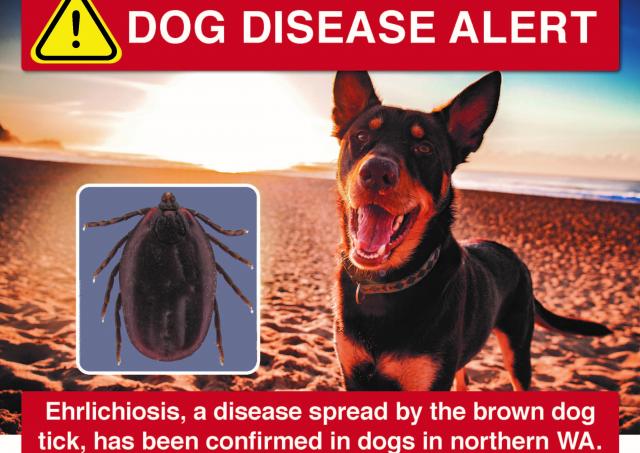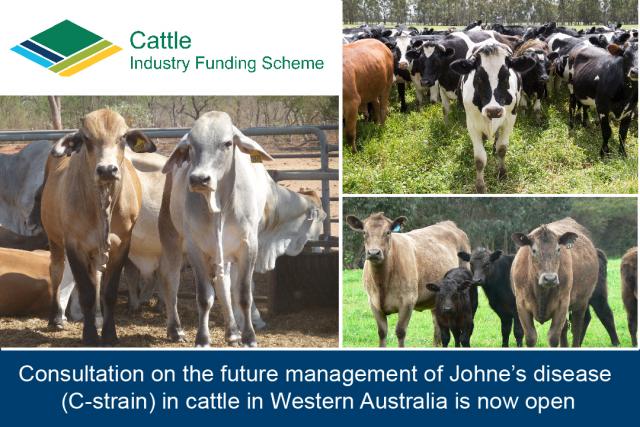| The WA Livestock Disease Outlook - for producers provides information about recent livestock disease cases in Western Australia and diseases likely to occur in the next month. Calling a vet to investigate diseases when they occur provides surveillance evidence to our markets that we are free of reportable and trade-relevant diseases. |
Protect your dogs from ehrlichiosis

The exotic dog disease, ehrlichiosis, was detected in Australia for the first time this year in the Kimberley, Pilbara and Gascoyne as well as the Northern Territory. The disease is spread by the bite of an infected brown dog tick, which is common across the north of Australia.
Dog owners in northern WA and travellers to and from northern WA should:
- ensure their dogs are on an ongoing effective tick treatment
- check their dogs daily for ticks.
Any signs of ehrlichiosis in dogs such as fever, lethargy, enlarged lymph nodes, loss of appetite, weight loss and unusual bleeding must be reported to a vet as this is a nationally notifiable disease.
People moving their dogs south out of the Kimberley, where the disease is established, must:
- fill out a form to notify DPIRD and
- only move the dog if it is healthy and on a tick treatment.
Read more about the signs of ehrlichiosis and how to reduce the risk in your dogs.
Recent livestock disease cases in WA
Annual ryegrass toxicity in horse with neurological signs
- A number of exotic and reportable viral diseases can cause neurological signs in horses, including equine encephalitis (eastern, western and Venezuelan), equine herpesvirus-1, Hendra virus and rabies. Negative test results support our freedom from these diseases. For this reason, owners are encouraged to contact their vet or a DPIRD vet if they see neurological signs in horses. Subsidised testing is available for investigations where a reportable or exotic disease is suspected.
- A private vet examined a four-year-old horse with uncoordinated hind legs, muscle tremors and exaggerated reactions to stimuli. The vet considered the most likely cause was annual ryegrass toxicity (ARGT) but wanted to rule out exotic or reportable diseases as these also cause neurological signs. They submitted blood, faeces and feed samples to DPIRD for testing.
- The DPIRD lab findings indicated the disease was likely due to ARGT with the hay sample returning a ‘high risk’ result for toxicity. DPIRD recommended removing the animals from this feed to prevent further disease.
- The results also showed the horse’s disease signs were not due to exotic diseases or the reportable diseases Australian bat lyssavirus (ABLV), West Nile (Kunjin) virus, Murray Valley encephalitis, flavivirus and Ross River virus.
- The test results also showed the horse had previously been exposed to equine herpesvirus-4, which is widespread in horses in WA and preventable by vaccination. This disease usually causes a mild respiratory illness, and so was unlikely to be contributing to illness in this horse.
- Owners can help to reduce the risk of ARGT occurring in their horses and other livestock by inspecting animals daily for neurological signs and requesting a vendor declaration when buying hay that states the feed is ‘low risk’.
Salmonellosis causes deaths in cows and calves
- From April to June, DPIRD diagnosed 10 cases of salmonellosis in cattle and sheep. The most common disease signs reported by the producers or vets were diarrhoea, fever and sudden death.
- In one of those cases, a producer reported deaths in his first calving heifers to DPIRD. A field vet attended the property to investigate the deaths. Five heifers had died from a group of 130 over the course of a week. Additionally a mature cow had died in a group of 70 and some of the cows had severe diarrhoea.
- A post-mortem showed one heifer had marked inflammation on the lining of the abomasum (fourth stomach). Tissue, fluid and faecal samples were submitted to the DPIRD lab to investigate further.
- The lab detected Salmonella Typhimurium in the intestinal contents and faecal samples from two cows. Additionally liver samples showed low copper levels, which can result in poor growth and ill-thrift, diarrhoea, coat pigment loss, bone fragility, and anaemia. Read more about preventing copper deficiency in sheep and cattle.
- Producers can help prevent Salmonella infections by reducing livestock stressors such as unnecessary mustering and yarding where possible. Good nutrition, parasite management and management practices that eliminate long periods without feed and water will minimise the risk of outbreaks.
- Calling a vet to investigate signs of Salmonella is important to ensure it is not a reportable strain such as S. abortus ovis in sheep, S. abortus equi in horses, and S. enteritidis and S. pullorum infection in poultry. Testing for these diseases helps to provide animal health data to support our livestock markets as well as ensuring the disease is appropriately managed.
- Salmonella can be transmitted to people, so where salmonellosis is suspected, producers should take steps to protect themselves from infection by wearing gloves, and washing hands and changing clothes after handling suspect cases.
In early spring, watch for these livestock diseases
Calf diarrhoea/scours
- Affects young calves and is usually caused by a combination of predisposing environmental conditions (such as poor nutrition, lack of shelter and cleanliness during calving) and infectious organisms. Newborn calves that receive a good supply of colostrum from their dams will be better protected.
- Signs include depressed appearance; white, yellow, grey or blood-stained diarrhoea; dehydration; reluctance to rise; and death.
- Calf scours may result from single or multiple causes. Some common causes include infection with bovine coronavirus (not the same as COVID-19), rotavirus, E. coli, Salmonella and Cryptosporidium. Cows can be vaccinated against a number of these diseases before calving.
- DPIRD’s calf scours webpage outlines a number of strategies for producers to prevent and treat an outbreak.
Listeriosis
- Caused by the bacteria Listeria monocytogenes.
- Sources of infection include spoiled silage, rotten vegetables, contaminated soil, spoiled feed and where apparently healthy animals (including rodents) have shed the bacteria in their faeces.
- Livestock that consume contaminated feed material can be infected when rough feed causes abrasions in the mouth.
- Key signs: neurological signs (such as circling), unwillingness to rise and deaths. May also cause abortions 5–6 weeks before lambing, stillbirths or newborn lamb deaths.
- If feeding silage, ensure it has been properly prepared and any leftover feed is cleared away promptly to prevent spoilage.
- Listeriosis is zoonotic (can infect people). Producers should take precautions when handling sick stock and pregnant and immune-compromised people should avoid contact with potentially infected animals and aborted materials.
Have your say on the future management of Johne’s disease (C-strain) in cattle in WA

The Cattle Industry Funding Scheme Management Committee (IFSMC) is calling for submissions from the WA cattle industry on the future management of Johne’s disease (C-strain) in cattle in WA.
Western Australian beef, dairy and stud producers, industry bodies, exporters, livestock agents, processors, transporters, veterinarians and government agencies are invited to have their say.
Following national deregulation of Johne’s disease (JD) in cattle in 2016, the WA cattle industry requested continuing state regulation of JD (C-strain) in cattle. Cattle IFSMC funded a control program that included targeted surveillance for JD (C strain) in cattle in WA to establish WA’s current JD (C-strain) status. The completed surveillance showed there was a very low risk of the disease being present in WA cattle.
The WA cattle industry, through the Cattle IFSMC, is now being asked to decide whether JD (C-strain) in cattle continues to be managed through state regulation and, if so, under what conditions – or is deregulated and individual stakeholders manage their own biosecurity to prevent and manage JD on their properties.
There are several options to consider, and industry members are encouraged to read the consultation paper and view the webinar before making a submission on their preferred option. The consultation closes on 2 September 2020.
For more information and to make a submission, see the consultation webpage.
Following the close of the consultation, the Cattle IFSMC will convene a meeting with industry representatives to consider the submissions and facilitate a decision by industry.
